Spatial Optimization of Residential Care Facility Configuration Based on the Integration of Modified Immune Algorithm and GIS: A Case Study of Jing’an District in Shanghai, China
Abstract
1. Introduction
2. Methods
2.1. Optimization Model
2.1.1. Maximizing Equity
2.1.2. Maximizing Efficiency of Configuration
2.1.3. Minimizing Travel Costs
2.1.4. Maximizing Profits
- (1)
- The number of RCFs selected from candidate sites should be equal to a predefined number p, namely:
- (2)
- The elderly in every population center can get the service from a RCF, namely:
- (3)
- For each selected RCF candidate site, it will serve at least one population center, namely:
- (4)
- According to the Special Plan for the Layout of RCFs in Shanghai, RCFs are divided into 3 types: small-sized (the number of beds should be less than 100), medium-sized (the number of beds should be between 100 and 300), and large-sized (the number of beds should be between 300 and 500), and the RCFs of Jing’an District, which is located in the downtown area of Shanghai, should be small-sized or medium-sized, and the number of beds here should be between 0 and 300, namely:
2.2. Modified Immune Algorithm
2.2.1. Variable Threshold for Selection Operator
2.2.2. Guo Elite Mutation Operator
2.2.3. Periodically Varying Mutation Probability
2.2.4. The Perturbations of Global Optima
- Step 1:
- Initialization. The simple decimal encoding is used to initialize an antibody population as a set of randomly generated decision vectors within the predefined feasible solutions. Each antibody represents a candidate solution, which is the sequence of the RCFs selected from the candidate sites.
- Step 2:
- Calculation. In this step, the affinity and the concentration of antibodies are calculated, and some excellent antibodies to store in the memory bank are selected.
- Step 3:
- Memory cell updating. Replace the memory cells whose affinities with antigens are worse with the excellent antibodies. At the same time, for those that have worse affinities with memory cells, their ability is reduced to survive to ensure that the algorithm will not get stuck in local optima.
- Step 4:
- Clonal selection. According to variable threshold for selection operator, a certain number of antibodies with great affinities and low concentrations are selected to be cloned.
- Step 5:
- Mutation. Mutation means random change the permutation of encoding. At this stage, the Guo elite mutation operator is applied to improve the search efficiency, and the periodic varying mutation probability is used to increase the diversity of antibody populations.
- Step 6:
- Perturbation. The global optima is perturbed at set intervals to avoid getting stuck in the local optima.
- Step 7:
- Termination. If , go to step 2; otherwise, terminate the procedure.
2.3. Integration of MIA and GIS
3. Model Implementation and Results
3.1. Study Area
3.2. Data Sources
3.3. Definition of Candidate Sites for RCFs
3.4. Sensitivity Analysis of β
3.5. Rationality Analysis of Existing RCFs
3.5.1. Quantity
3.5.2. Scale
3.5.3. Location
4. Optimization and Results
5. Discussion
5.1. Comparison of Optimization Scheme with the Current Situation of RCF Configuration
- (1)
- For the government: Firstly, the equity of RCF configuration improves. Table 4 shows that the configuration scheme for RCFs after optimization has 64.23% improvement in equity compared with the current situation. The Gini coefficient of potential service resources available to residents has also dropped from 0.5563 to 0.1225. The Gini coefficient was originally used to measure people’s income equity. In recent years, it has been used by some researchers to reflect the equity of public resource allocation [44]. The lower the Gini coefficient is, the better the equity of resource allocation will be. In addition, the ratio of the accessibility from each population center to the RCF and the average value of the accessibility can also reflect the equity of RCF configuration. The closer the value is to 1, the better the equity of RCF configuration. Figure 6a indicates that 72.83% of the population centers have this ratio indicator between 0.9 and 1.1, which indicates that most population centers can obtain services of RCFs evenly after optimization. Secondly, the efficiency of the RCF configuration improves. The 45 RCFs, including 39 existing RCFs and 6 new RCFs, are able to meet the care demands of all the elderly in Jing’an District after optimization. Table 4 shows that the configuration efficiency of RCFs has been improved by 84.24%. As mentioned above, due to the irrational locations and scales, existing RCFs cannot meet the actual demands, resulting in low service capabilities. When the demand-oriented optimization method is used, the configuration of the RCFs is more balanced, which is more conducive to improving configuration efficiency.
- (2)
- For the investors: Table 4 shows that the economic efficiency of investment has been improved by 29.82%. Therefore, with the optimization of the RCF configuration, the care demands of more and more elderly people are met, while the economic efficiency of investors can also be greatly improved.
- (3)
- For the elderly: Residents’ travel becomes more convenient and efficient. Figure 6b shows that the per capita travel cost is significantly reduced after optimization, and travel efficiency in 99% of population centers has been improved to some degree. From the perspective of the spatial layout of RCFs, there is at least one RCF near each population center. The maximum travel distance from population centers to their nearest RCF is reduced from 2150 m to 1374 m, with the average travel distance reduced from 526 m to 373 m. In addition, the average number of beds available for each population center within a one-hour service radius is increased from 1.5624 to 3.3986, indicating that the optimization scheme has achieved the goal of 2.5 beds per 100 elderly people proposed in the Special Plan for the Layout of RCFs in Shanghai. The above results reveal that the convenience of RCF services after optimization has been improved.
5.2. Comparison of the Performance of MIA with Other Algorithms
6. Conclusions
Author Contributions
Funding
Acknowledgments
Conflicts of Interest
References
- Old-Age Scientific Research Center in Shanghai. 2019. Available online: http://www.shweilao.cn/views/index/headlinesList.jsp?type=7 (accessed on 20 May 2020).
- Old-age Scientific Research Center in Shanghai. 2014. Available online: http://www.shweilao.cn/cms/cmsDetail?uuid=67a5ba7a-c457-4f70-a460-71f4f2fff602 (accessed on 16 October 2014).
- Sun, Y. Aged care facility planning of metropolitan Shanghai based on growth of the elderly population. World Reg. Stud. 2016, 25, 121–130. (In Chinese) [Google Scholar]
- Sima, L. A study on the characteristics of spatial distribution of care facilities and capacities for the elderly in Shanghai. Arch. J. 2018, 2, 90–94. (In Chinese) [Google Scholar]
- Fret, B.; Mondelaers, B.; Donder, D.L.; Switsers, L.; Smetcoren, A.S.; Verté, D. The D-SCOPE Consortium. Exploring the cost of ‘ageing in place’: Expenditures of community-dwelling older adults in Belgium. Ageing Int. 2018. [Google Scholar] [CrossRef]
- Jiang, Y.; Rhee, M.K.; Cho, Y.J.; Kim, N. Willingness to use a nursing home in Asian Americans. J. Immigr. Minor. Health 2019, 21, 668–673. [Google Scholar] [CrossRef]
- Marieke, V.D.; Eva, U.B.; Clara, H.M. Health and its relationship with residential re-locations of older people to institutions versus to independent dwellings. J. Popul. Ageing 2018, 11, 329–347. [Google Scholar]
- Mijaur, R.; Jimmy, T.E.; Hal, K.; Julie, E.B. Patterns of home and community care use among older participants in the Australian longitudinal study of women’s health. Eur. J. Ageing 2019, 16, 293–303. [Google Scholar]
- Blažienė, I.; Žalimienė, L. Between user’s expectations and provider’s quality of work: The future of elderly care in Lithuania. J. Popul. Ageing 2020, 13, 5–23. [Google Scholar] [CrossRef]
- Havig, A.A.; Hollister, B. How does leadership influence quality of care? towards a model of leadership and the organization of work in nursing homes. Ageing Int. 2018, 43, 366–389. [Google Scholar] [CrossRef]
- Johnson, S.; Madan, S.; Vo, J.; Pottkett, A. A qualitative analysis of the emergence of long term care (old age home) sector for seniors care in India: Urgent call for quality and care standards. Ageing Int. 2018, 43, 356–365. [Google Scholar] [CrossRef]
- Shaw, S.; Sahoo, H. Accessibility to primary health centre in a tribal district of Gujarat, India: Application of two step floating catchment area model. GeoJournal 2019. [Google Scholar] [CrossRef]
- Tuyen, Q.T.; Huong, V.V. A microeconometrics analysis of housing and life satisfaction among the Vietnamese elderly. Qual. Quant. 2018, 52, 849–867. [Google Scholar]
- Ji, X.; Xiao, B.; Sun, Q. The research of planning and configuration layout strategy on urban institution endowment service facilities: A case study of main city zone of Xuzhou. Mod. Urban Res. 2017, 32, 27–32. (In Chinese) [Google Scholar]
- Liu, Y.; Jing, Y.; Zhang, L.; Liu, J. Assessing spatial accessibility of public and private residential aged care facilities: A case study in Wuhan, central China. ISPRS Int. J. Geo Inf. 2017, 6, 304–320. [Google Scholar]
- Li, L.; Zhang, J.; Qiu, B.; Gu, T. Allocation optimization for elderly facilities in public housing community: A case study in Nanjing city. Mod. Urban Res. 2016, 31, 11–15. (In Chinese) [Google Scholar]
- Nishino, T. Quantitative properties of the macro supply and demand structure for care facilities for elderly in Japan. Int. J. Environ. Res. Public Health 2017, 14, 1489. [Google Scholar] [CrossRef]
- Jia, M.; Zhou, Y.; Lin, J. The privatisation and the unbalanced spatial development of residential care for the elderly: The case of Beijing, China. Appl. Spat. Anal. Policy 2018, 11, 59–80. [Google Scholar] [CrossRef]
- Li, W.; Huan, S.; Lu, G. Healthcare facility location-allocation optimization for China’s developing cities utilizing a multi-objective decision support approach. Sustainability 2018, 10, 4580. [Google Scholar]
- Tao, Z.; Cheng, Y.; Dai, T.; Rosenberg, M.W. Spatial optimization of residential care facility locations in Beijing, China: Maximum equity in accessibility. Int. J. Health Geogr. 2014, 13, 33–44. [Google Scholar] [CrossRef]
- Zhou, H.; Song, M.; Pedrycz, W. A comparative study of improved GA and PSO in solving multiple traveling salesmen problem. Appl. Soft Comput. 2018, 64, 564–580. [Google Scholar] [CrossRef]
- Wang, F.; Zhang, H.; Li, K.; Lin, Z.; Yang, J.; Shen, X. A hybrid particle swarm optimization algorithm using adaptive learning strategy. Inf. Sci. 2018, 436, 162–177. [Google Scholar] [CrossRef]
- Jerne, N. Towards a network theory of the immune system. Ann. Immunol. 1974, 125, 373–389. [Google Scholar]
- Liu, X.; Li, X.; Tan, Z.; Chen, Y. Zoning farmland protection under spatial constraints by integrating remote sensing, GIS and artificial immune systems. Int. J. Geogr. Inf. Sci. 2011, 25, 1829–1848. [Google Scholar] [CrossRef]
- Yang, B. Dynamic risk identification safety model based on fuzzy support vector machine and immune optimization algorithm. Saf. Sci. 2019, 118, 205–211. [Google Scholar] [CrossRef]
- Samigulina, G.A.; Samigulina, Z.I. Modified immune network algorithm based on the random forest approach for the complex objects control. Artif. Intell. Rev. 2018, 52, 2457–2473. [Google Scholar] [CrossRef]
- Wang, F.; Tang, Q. Planning toward equal accessibility to services: A quadratic programming approach. Environ. Plan. B Plan. Des. 2013, 40, 195–212. [Google Scholar] [CrossRef]
- Vale, D.S.; Pereira, M. The influence of the impedance function on gravity-based pedestrian accessibility measures: A comparative analysis. Environ. Plan. B Urban Anal. City Sci. 2017, 44, 740–763. [Google Scholar] [CrossRef]
- Wismadi, A.; Zuidgeest, M.; Brussel, M.; Maarseveen, M. Spatial preference modelling for equitable infrastructure provision: An application of Sen’s capability approach. J. Geogr. Syst. 2014, 16, 19–48. [Google Scholar] [CrossRef]
- Chakravorty, A.; Laha, D. A heuristically directed immune algorithm to minimize makespan and total flow time in permutation flow shops. Int. J. Adv. Manuf. Technol. 2017, 9–12, 3759–3776. [Google Scholar] [CrossRef]
- Huang, K.; Liu, X.; Li, X.; Liang, J.; He, S. An improved artificial immune system for seeking the Pareto front of land-use allocation problem in large areas. Int. J. Geogr. Inf. Sci. 2013, 27, 922–946. [Google Scholar] [CrossRef]
- Jiang, X.; Yu, Y.; Zhao, L. Constrained non-dominated neighbor immune multi-objective optimization algorithm for multimedia delivery. Multimed. Tools Appl. 2017, 16, 17297–17317. [Google Scholar] [CrossRef]
- Zhang, C.; Jia, L.; Wang, J. An improved hybrid immune algorithm for multi-modal optimization. J. Cent. South Univ. 2016, 47, 1940–1946. (In Chinese) [Google Scholar]
- An, J.; Xu, S. A PSO theory integrated improved GUO TAO algorithm and its application. Comput. Appl. Softw. 2014, 31, 296–299. (In Chinese) [Google Scholar]
- Huang, Q.; Zhao, H.; Chen, L. Research of combined forecasting model based on improved PSO. Comput. Eng. Appl. 2015, 51, 258–263. (In Chinese) [Google Scholar]
- Government of Jing’an District, Shanghai. Available online: http://english.jingan.gov.cn/qq/006001/20170927/53aa475c-e38a-4152-a6c4-19f491cb6cc9.html (accessed on 1 January 2020). (In Chinese)
- Shanghai Civil Administration Bureau. Available online: http://app.mzj.sh.gov.cn/sample/Gis.aspx?objectid=166&firstarea=&pageindex=1 (accessed on 1 October 2019).
- Shanghai Bureau of Statistics. Available online: http://tjj.sh.gov.cn/tjnj/20190117/0014-1003014.html (accessed on 1 January 2018). (In Chinese)
- Han, Z.; Du, P.; Wang, L. Method for optimization allocation of regional public service infrastructure: A case study of Xinghua street primary school. Sci. Geogr. Sin. 2018, 34, 803–809. [Google Scholar]
- Peeters, D.; Thomas, I. Distance predicting functions and applied location—Allocation models. J. Geogr. Syst. 2000, 2, 167–184. [Google Scholar] [CrossRef]
- Cheng, Y.; Wang, J.; Rosenberg, M.W. Spatial access to residential care resources in Beijing, China. Int. J. Health Geogr. 2012, 11, 32–43. [Google Scholar] [CrossRef]
- State Council in China. Available online: http://www.gov.cn/zhengce/content/2013-09/13/content_7213.htm (accessed on 13 September 2013). (In Chinese)
- State Council in China. Available online: http://www.gov.cn/zhengce/content/2019-04/16/content_5383270.htm (accessed on 16 April 2019). (In Chinese)
- Cai, W.; Li, C.; Sun, M. Measuring inequalities in the public health workforce at county-level centers for disease control and prevention in China. Int. J. Equity Health 2019, 1, 179–191. [Google Scholar] [CrossRef] [PubMed]
- Cheng, M.; Cui, X. Spatial optimization configuration of the residential care homes based on the multi-objective improved immune algorithm and GIS: A case study of Hongkou district in Shanghai. Sci. Geogr. Sin. 2018, 38, 2049–2057. [Google Scholar]
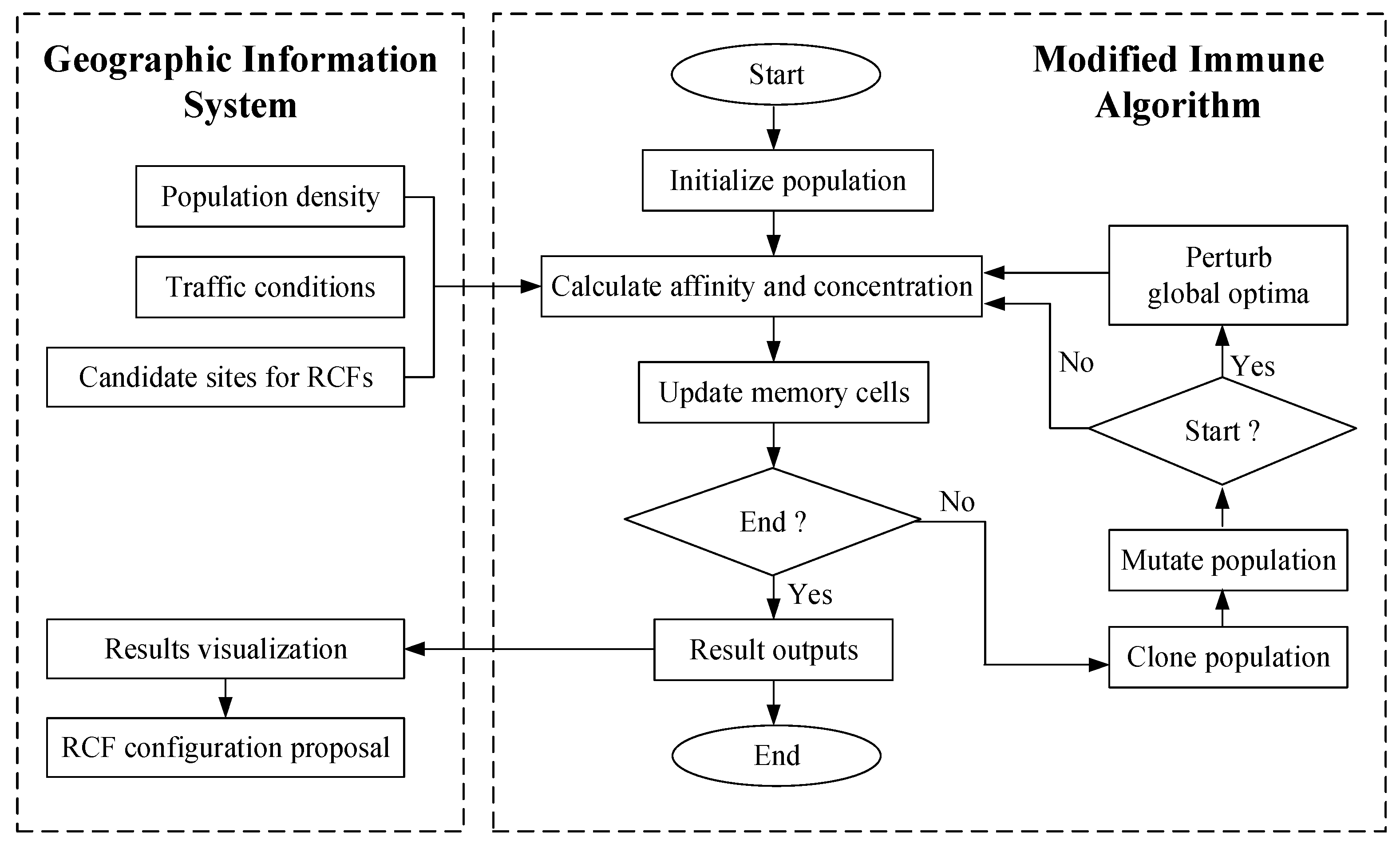
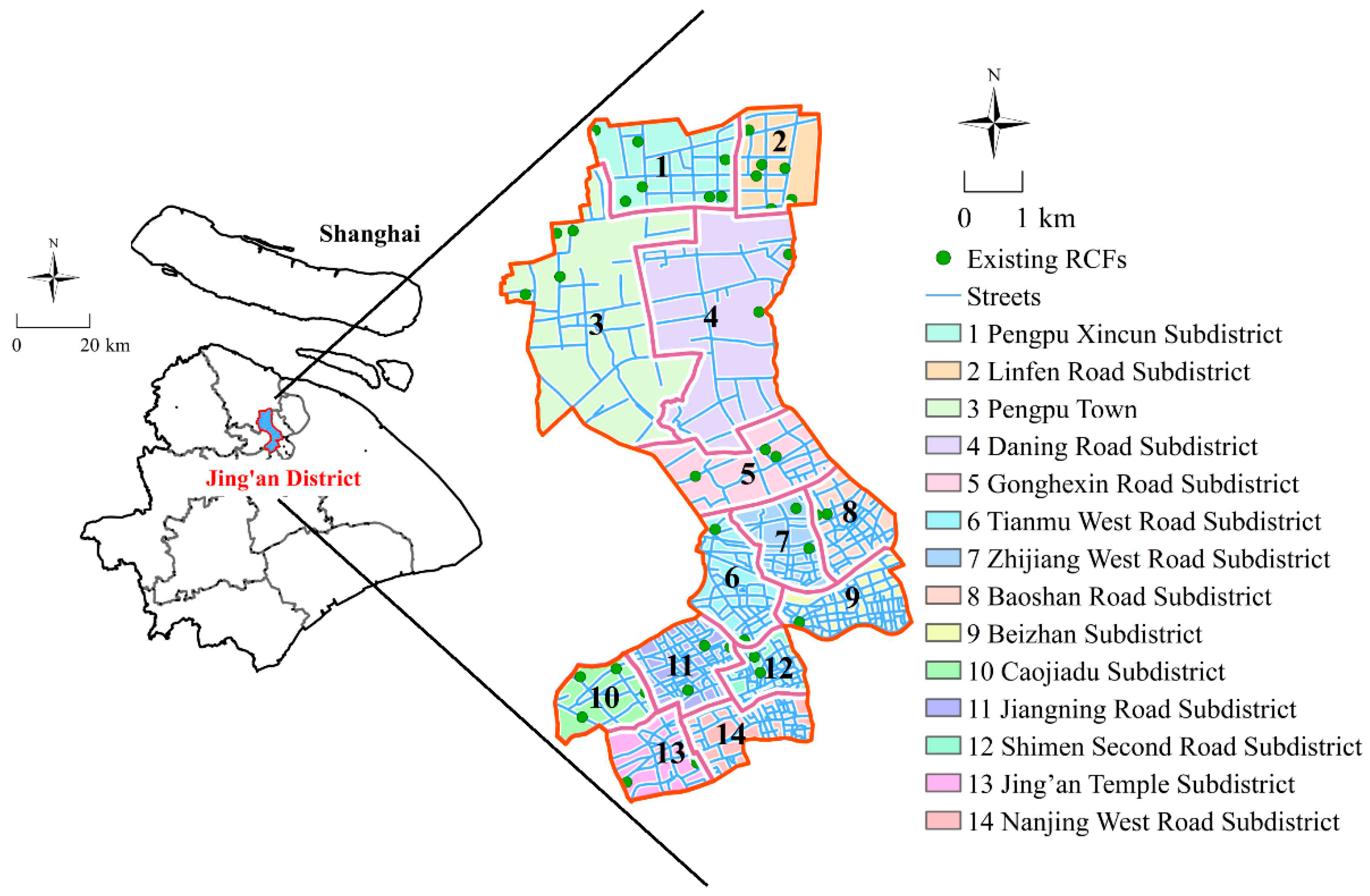
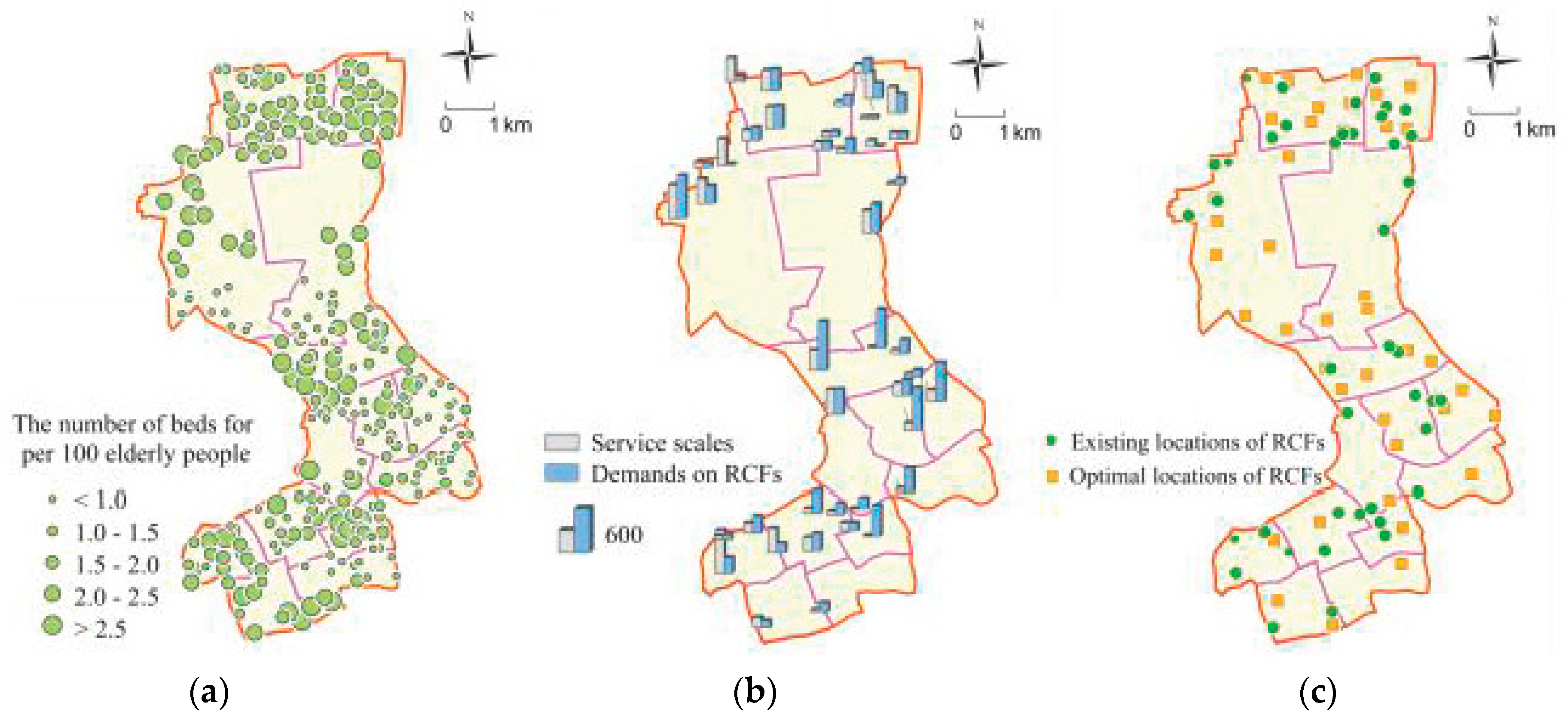
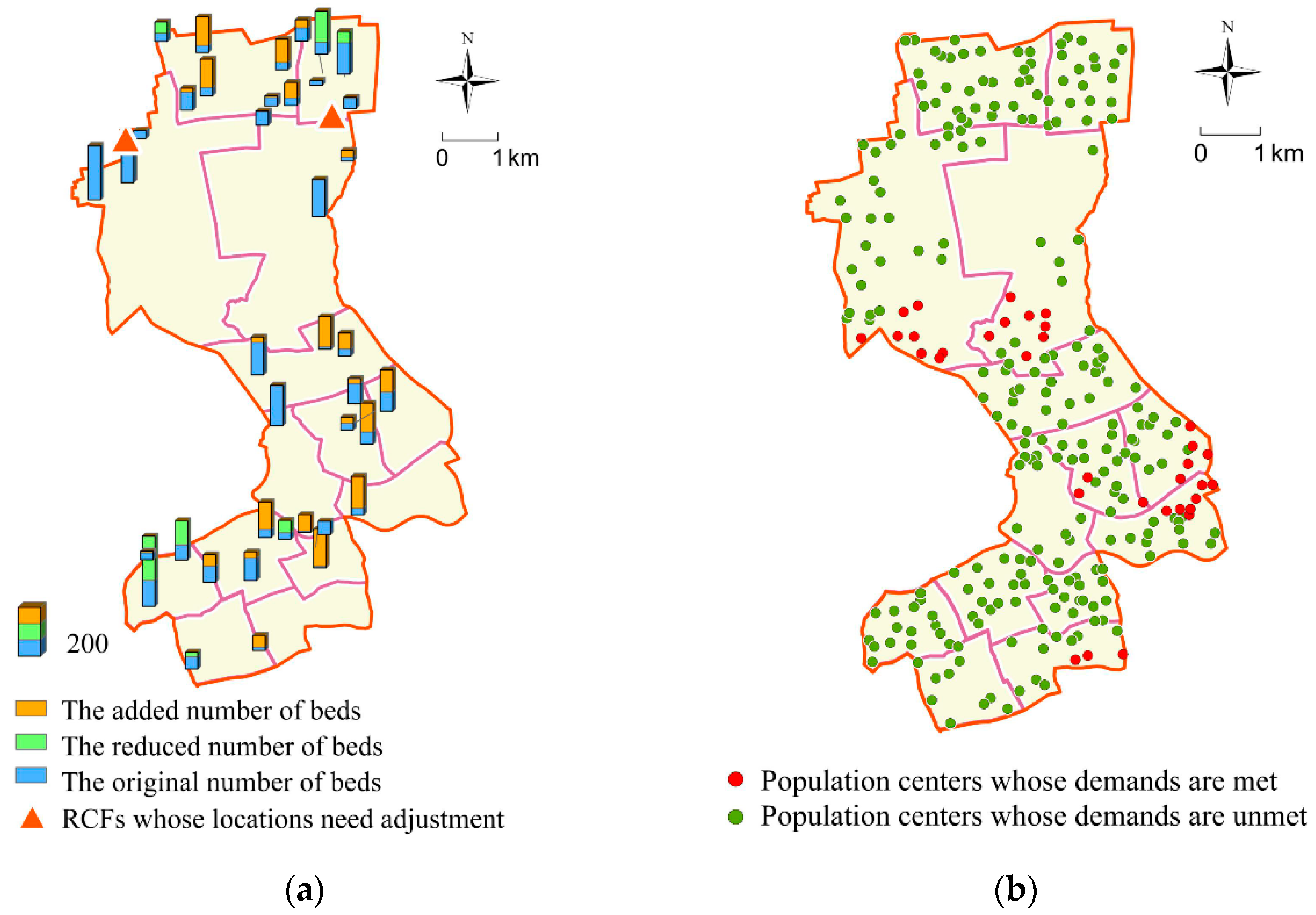
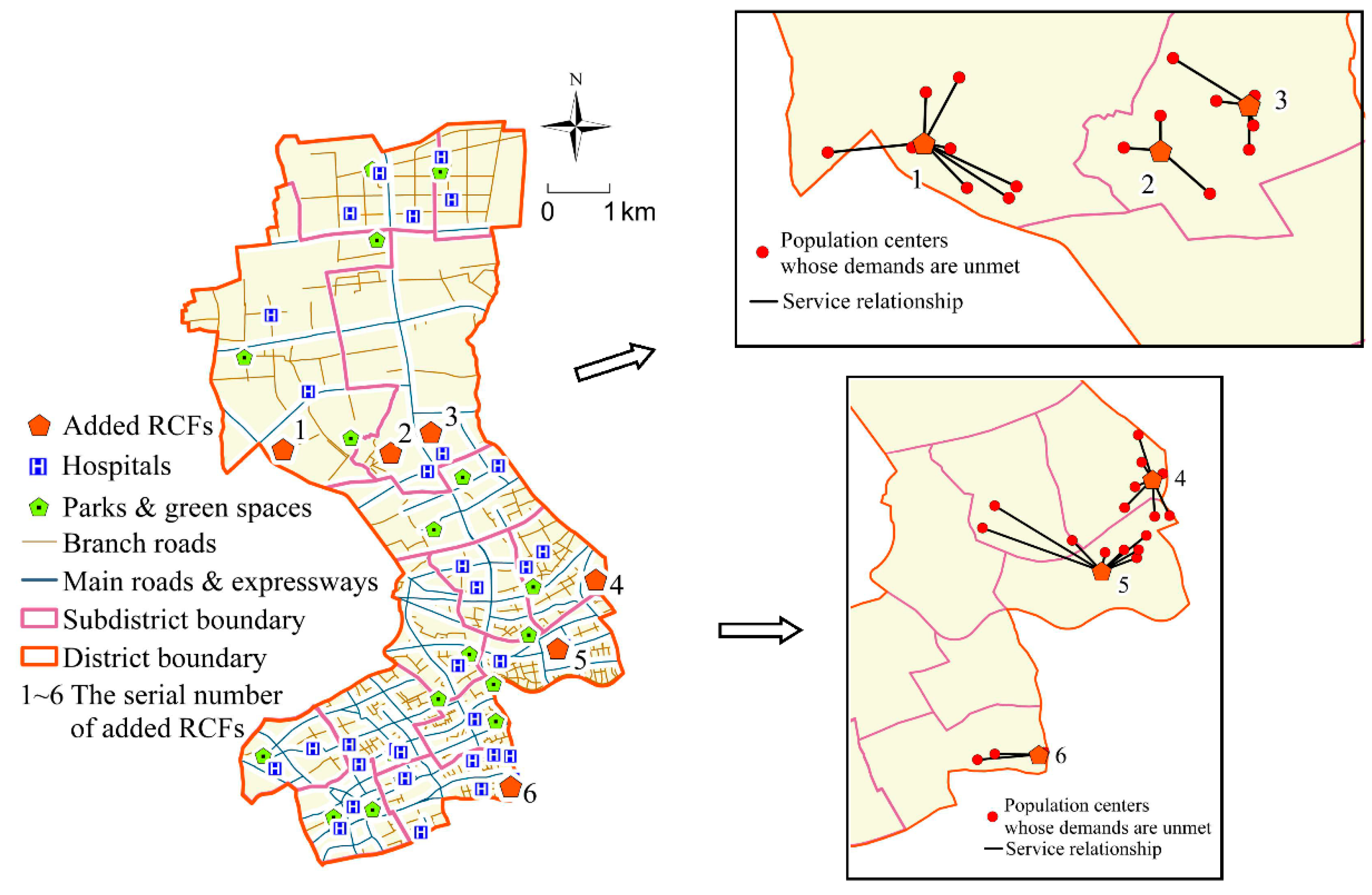
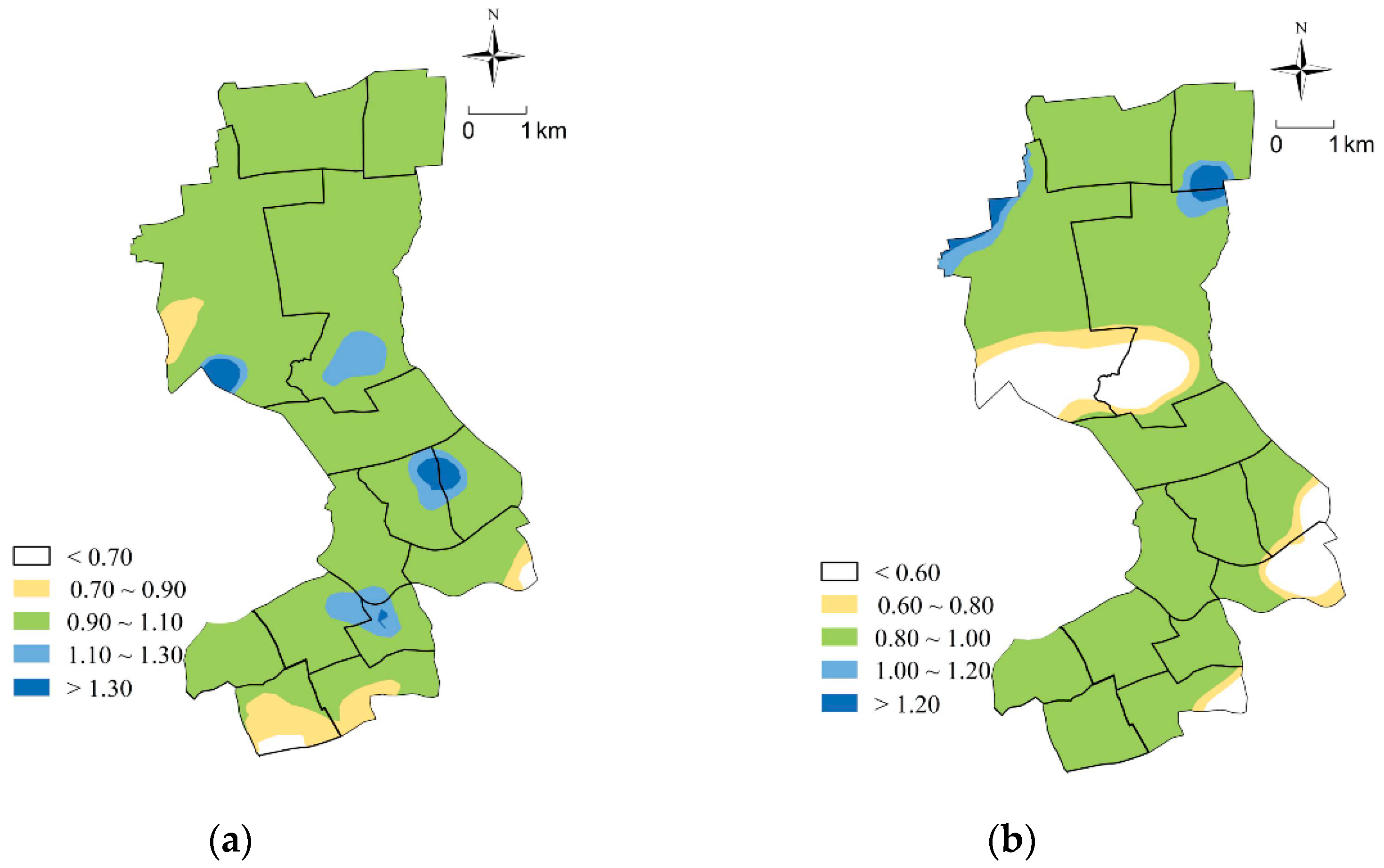
| β | Accessibility | ||
|---|---|---|---|
| Maximum | Minimum | Standard Deviation | |
| 0.8 | 2.3879 | 0.3917 | 0.6854 |
| 1 | 4.1041 | 0.4799 | 0.5018 |
| 1.2 | 7.2491 | 0.3702 | 0.8662 |
| 1.4 | 12.4549 | 0.2694 | 1.4351 |
| 1.6 | 20.2442 | 0.1849 | 2.2596 |
| 1.8 | 30.8292 | 0.1206 | 3.3662 |
| 2 | 44.0078 | 0.0756 | 4.7404 |
| 2.2 | 59.2022 | 0.0460 | 6.3264 |
| 2.4 | 75.5945 | 0.0275 | 8.0405 |
| The Number of RCFs | 4 | 5 | 6 | 7 | 8 | 9 | 10 | 11 | 12 | 13 | 14 |
|---|---|---|---|---|---|---|---|---|---|---|---|
| Objective Function Value | 0.6722 | 0.6323 | 0.6012 | 0.6283 | 0.6501 | 0.6766 | 0.7149 | 0.7364 | 0.7626 | 0.7943 | 0.8243 |
| RCF No. | 1 | 2 | 3 | 4 | 5 | 6 |
|---|---|---|---|---|---|---|
| The number of beds | 285 | 181 | 257 | 247 | 143 | 80 |
| Objectives | Results | ||
|---|---|---|---|
| Current Situation | Optimized Scheme | Optimization Rate | |
| Equity | 56.2886 | 17.2883 | 64.23% |
| Efficiency (%) | — | 84.24 | 84.24% |
| Travel cost (m/person) | 544.9192 | 389.4611 | 18.53% |
| Profits of investor (RMB/month/RCF) | 111,785 | 145,120 | 29.82% |
| Gini coefficient | 0.5563 | 0.1225 | 77.98% |
| Max travel distance to nearest RCF (m) | 2150 | 1374 | 36.09% |
| Average travel distance to nearest RCF (m) | 526 | 373 | 29.09% |
| The average number of beds available within one-hour service radius (beds/person) | 1.5624 | 3.3986 | 117.52% |
| Objectives | Results | |||
|---|---|---|---|---|
| GA | PSO | IA | MIA | |
| Equity (number of beds/person)2 | 19.6840 | 20.5275 | 18.2745 | 17.2883 |
| Efficiency (%) | 82.41 | 83.14 | 83.67 | 84.24 |
| Travel cost (m/person) | 408.4216 | 424.4999 | 411.8927 | 389.4611 |
| Profits of investor (RMB/ month) | 141,970 | 138,940 | 145,120 | 145,120 |
| Comprehensive objective value | 0.7323 | 0.8064 | 0.6401 | 0.6012 |
| Number of iterations | 650 | 680 | 700 | 480 |
Publisher’s Note: MDPI stays neutral with regard to jurisdictional claims in published maps and institutional affiliations. |
© 2020 by the authors. Licensee MDPI, Basel, Switzerland. This article is an open access article distributed under the terms and conditions of the Creative Commons Attribution (CC BY) license (http://creativecommons.org/licenses/by/4.0/).
Share and Cite
Cheng, M.; Cui, X. Spatial Optimization of Residential Care Facility Configuration Based on the Integration of Modified Immune Algorithm and GIS: A Case Study of Jing’an District in Shanghai, China. Int. J. Environ. Res. Public Health 2020, 17, 8090. https://doi.org/10.3390/ijerph17218090
Cheng M, Cui X. Spatial Optimization of Residential Care Facility Configuration Based on the Integration of Modified Immune Algorithm and GIS: A Case Study of Jing’an District in Shanghai, China. International Journal of Environmental Research and Public Health. 2020; 17(21):8090. https://doi.org/10.3390/ijerph17218090
Chicago/Turabian StyleCheng, Min, and Xiao Cui. 2020. "Spatial Optimization of Residential Care Facility Configuration Based on the Integration of Modified Immune Algorithm and GIS: A Case Study of Jing’an District in Shanghai, China" International Journal of Environmental Research and Public Health 17, no. 21: 8090. https://doi.org/10.3390/ijerph17218090
APA StyleCheng, M., & Cui, X. (2020). Spatial Optimization of Residential Care Facility Configuration Based on the Integration of Modified Immune Algorithm and GIS: A Case Study of Jing’an District in Shanghai, China. International Journal of Environmental Research and Public Health, 17(21), 8090. https://doi.org/10.3390/ijerph17218090




